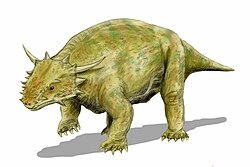| Nanoparia Temporal range: Changhsingian, | |
|---|---|
 | |
| Life reconstruction | |
| Scientific classification | |
| Kingdom: | Animalia |
| Phylum: | Chordata |
| Class: | Reptilia |
| Subclass: | † Parareptilia |
| Order: | † Procolophonomorpha |
| Clade: | † Pareiasauria |
| Clade: | † Pumiliopareiasauria |
| Genus: | † Nanoparia Broom, 1936 |
| Type species | |
| †Nanoparia luckhoffi Broom, 1936 | |
Nanoparia is an extinct genus of pareiasaur that lived in the Permian.



